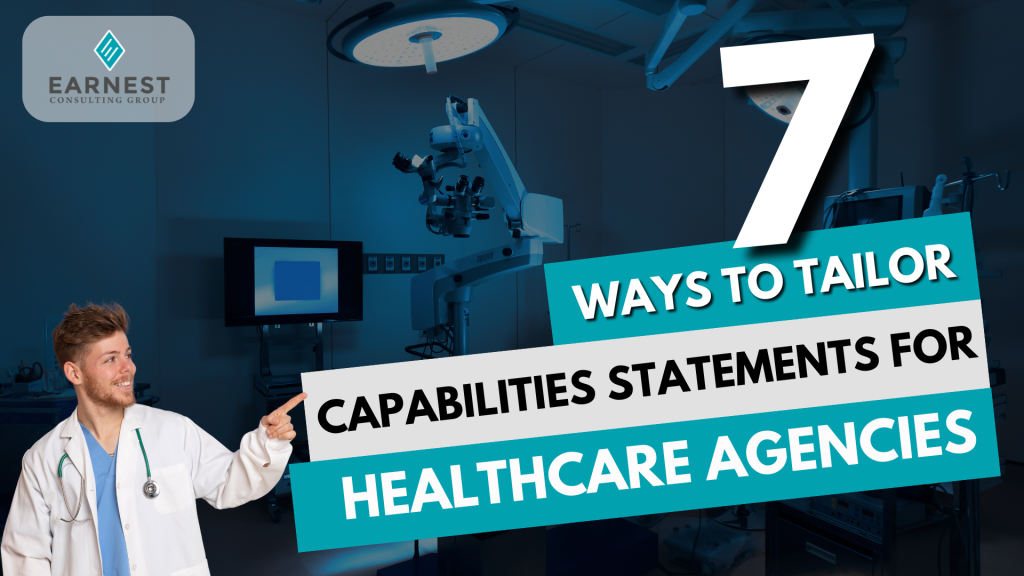7 Ways to Tailor Capabilities Statements for Healthcare Agencies
April 23, 2025 | Government
If your target audience includes the Department of Veterans Affairs, HHS, or any of the subagencies in the Federal health sector, your capabilities statement shouldn’t look like a one-size-fits-all brochure. Healthcare buyers have different missions, different stakeholders, and very different pain points compared to the average agency.
Here are seven specific ways to make your capabilities statement resonate in the healthcare space:
1. Speak Their Language (Literally and Figuratively)
Avoid jargon that feels generic. If you’re selling to healthcare agencies like the VA, HHS, or DHA (Defense Health Agency), use terminology from their world—terms like patient-centered care, EHR integration, interoperability, and Patient Aligned Care Team (PACT). These aren’t just trend phrases—they’re mission-critical frameworks and concepts. Mirror the language you see in their mission statements and recent procurements. It shows alignment and intentionality.
2. Highlight Clinical Outcomes, Not Just Technical Specs
Healthcare agencies aren’t buying tech for the sake of tech. They’re buying outcomes. So instead of “Our solution provides secure cloud storage,” say, “Our solution helped reduce data retrieval times by 45% across four medical centers, directly improving patient case management.”
3. Showcase Experience with Healthcare Stakeholders
A lot of capabilities statements only list agencies and contract numbers. That’s not enough. If you’ve worked with nurse managers, biomedical engineers, or healthcare informaticists, say so. Buyers want to know you understand the ecosystem they operate in.
4. Include Metrics That Matter to Them
Most healthcare agencies want to see metrics that tie back to patient access, data accuracy, time to treatment, or cost containment. Generic stats about app installs or licenses sold don’t hit the mark. Tailor your numbers to align with mission impact.
5. Make Compliance and Certification Front and Center
Is your product HIPAA-compliant? Is your team trained in ICD-10, HL7, or FHIR standards? Are you on the VA’s Technical Reference Model (TRM)? Don’t bury that in the fine print—lead with it.
6. Get Specific About What You Know They Need
If you know the customer is buying exam tables—start there. Open with your ability to deliver the exact model they’re already sourcing. If you’re staffing clinicians, and you know they need cardiologists or neurologists, don’t just say you staff clinical roles. Say you staff cardiologists and neurologists. The more precise you are, the faster they’ll connect the dots between their need and your solution.
7. Lead with Value, Not Status
It’s tempting to open with “We’re a woman-owned, SDVOSB-certified firm.” But the truth is, set-aside status is not a differentiator to most healthcare buyers. Instead, open with your outcomes and impact: “We support over 75,000 patients annually across federal and state health programs by streamlining eligibility and care coordination.”
Final Thought
If you’re serious about selling into the federal healthcare space, don’t just repurpose what worked for DHS or the Army Corps. Agencies like the VA, HHS, and DHA aren’t just different—they’re nuanced. Your capabilities statement should reflect that nuance, clearly showing that you understand their mission, their constraints, and their goals.
And before you walk into any meeting—do your research. Learn what’s important to that agency’s mission. Review the org chart to understand who you’re meeting with and who else might influence the decision. And here’s a tip: don’t bring your capabilities statement to the meeting. Use the meeting to learn what’s hot for them right now. Then go back, tailor your capabilities statement around what you heard, and send it as a thoughtful follow-up. That alone can set you apart.
« Back to Blog Home




